| Revision as of 14:44, 4 October 2020 editCitation bot (talk | contribs)Bots5,414,748 edits Alter: pages, template type, isbn. Add: author pars. 1-1. Removed parameters. Formatted dashes. Some additions/deletions were actually parameter name changes. | You can use this bot yourself. Report bugs here. | Suggested by AManWithNoPlan | All pages linked from cached copy of User:AManWithNoPlan/sandbox3 | via #UCB_webform_linked← Previous edit | Revision as of 04:32, 26 October 2020 edit undo201.201.215.44 (talk) Damn bro, you got the whole squad laughing.Tags: Reverted nowiki added Incorrectly formatted external link or image Visual editNext edit → | ||
| Line 1: | Line 1: | ||
| {{original research|date=November 2017}} | |||
| {{short description|Cuisine of Arab people}} | |||
| {{Arab cuisine}} | {{Arab cuisine}} | ||
| {{Arab culture}} | |||
| '''Arab cuisine''' ({{lang-ar|المطبخ العربي}}) is the cuisine of the ], defined as the various ]s spanning the ], from the ] to the ] and the ].<ref>{{cite book |last1=Flandrin|first1=Jean-Louis|last2=Montanari|first2=Massimo|first3=Albert |last3=Sonnenfeld|first4=Clarissa |last4=Botsford |title=Food: A Culinary History from Antiquity to the Present |date=1999|publisher=Penguin Books|location=New York|isbn=0-231-11154-1}}</ref> The cuisines are often centuries old and reflect the culture of great trading in ], herbs, and foods. The three main regions, also known as the ], the ], and the ], have many similarities, but also many unique traditions. These cuisines have been influenced by the climate, cultivating possibilities, as well as trading possibilities. | |||
| '''Arab cuisine''' ({{lang-ar|مطبخ عربي}}) is the cuisine of the ], defined as the various ]s spanning the ], from the ] to the ] and the ].<ref>{{cite book|last1=Flandrin|first1=under the direction of Jean-Louis|last2=al.]|first2=Massimo Montanari ; English edition by Albert Sonnenfeld ; translated by Clarissa Botsford ... ], herbs, and foods. The three main regions, also known as the ], the ], and the ] have many similarities, but also many unique traditions. These kitchens have been influenced by the climate, cultivating possibilities, as well as trading possibilities. The kitchens of the Maghreb and Levant are relatively young kitchens that were developed over the past centuries. The kitchen from the Khaleej region is a very old kitchen. The kitchens can be divided into the urban and rural kitchens. | |||
| ==Medieval cuisine== | |||
| ===Breads=== | |||
| The ] ''barazidhaj'' was made with high-quality wheat flour, similar to ''raqaq'' bread but thicker, the ] dough was leavened usually with yeast and "baker's ]" (''buraq'') and baked in a tandoor. One poetic verse describing this bread:<ref name=:2>{{cite book |last=Nasrallah |first=Nawal |title=Annals of the Caliphs' Kitchens |publisher=Brill |date=2007|pages=121–122}}</ref> | |||
| <blockquote><poem>"In the farthest end of Karkh of ], a baker I saw offering bread, splendidly marvelous. | |||
| From purest essence of wheat contrived. Radiant and absolute, you may see your image reflected, crystal clear. | |||
| ''Barazij'' rounds glowing with lovely whiteness, more playful than gorgeous singing girls, | |||
| They look like crystal trays, and were they indeed so, they would have served us as plates.</poem></blockquote> | |||
| ''Raqaq'' bread was made in two varieties, ''labiq'' (soft, thin flatbreads) and ''jarmazaj'' (dry, thin bread flavored with ] seeds). | |||
| ===Sauces=== | |||
| Numerous recipes for sauces (''sibagh'') have survived from historic ]. '']''{{dn|date=June 2020}} gives several recipes to be served with roasted fish, attributed to the various sources. To ] are credited two ''sibagh'' recipes. One prepared by adding ], ], thyme, ] and ] to mustard sauce, and another made by mashing vinegar soaked raisins with garlic, walnut, mustard, vinegar, and seasonings like asafetida and ]. From the seventh ] caliph ]'s recipe collection comes a ''sibagh'' made with ], walnut, garlic, olive oil and ]. There are similar recipes meant for poultry dishes prepared with seasonings like ginger, pomegranate, ] and cloves. | |||
| A surviving poem about sibagh is attributed to Caliph ]:<ref name=:1>{{cite book |last=Nasrallah |first=Nawal |title=Annals of the Caliphs' Kitchens |publisher=Brill |date=2007|pages=182–184}}</ref> | |||
| <blockquote><poem>The concept of ''sibagh'' is so subtle that none other than the smart can fathom. | |||
| Walnut and garlic with yogurt whey are the most you may need for it. | |||
| Or make it with vinegar, ''mahrut'', and coriander. But with ''anjudhan'' it will be even better. | |||
| If not, then mustard and garlic mixed with ''anjudhan'' and onion, equal parts, will make your relish. | |||
| Or with just vinegar and onion eat your fish and it will still be a tasty dish.</poem></blockquote> | |||
| ===Sweets=== | |||
| Described as the "food of kings" and "supreme judge of all sweets", '']'' was an almond-based ] that had entered ] by the 13th-century from ] influence, returning ] and Latin translations of cookery books. There are two versions of the dish known from medieval texts:<ref></ref> | |||
| #''Lauzinaj mugharraq'' or "drenched lauzinaj", this dish is believed to be an earlier version of the ] dish '']''. It was made by filling thin pastry dough with a mixtur e of ground almond (and sometimes other nuts like ] or ]), ], and sometimes luxury flavorings like ], ], or ]. | |||
| #''Lauzinaj yabis'' was made with ground almonds cooked in boiling honey or sugar until reaching a ] like consistency. The raw version, closer to ] in consistency, was made by blending the almonds with sugar and flavoring with ], musk and rosewater. The finished confection was molded into animal or other shapes, or cut into squares and triangles. | |||
| ===Vegetables=== | |||
| Vegetables included leeks, ], ], ], onions, ], ] and radish.<ref name=:3>{{cite book |last=Nasrallah |first=Nawal |title=Annals of the Caliphs' Kitchens |publisher=Brill |date=2007|pages=129}}</ref> Boiled asparagus was served with olive oil and ]. The cooking water was sweetened with honey and seasoned with cilantro, ], anise and black pepper, and used as a beverage either by itself with honey or added to wine.<ref name=:4>{{cite book |last=Nasrallah |first=Nawal |title=Annals of the Caliphs' Kitchens |publisher=Brill |date=2007|pages=221}}</ref> Some vegetables were consumed raw, but the following were usually boiled: asparagus, cauliflower, white soy beans, leeks, ], a variety of mushroom known as ''ghushina'', chard, cabbage, carrot, turnip, fresh ] and eggplant.<ref name=:5>{{cite book |last=Nasrallah |first=Nawal |title=Annals of the Caliphs' Kitchens |publisher=Brill |date=2007|pages=220}}</ref> | |||
| Some vegetable dishes were served cold. One example of such a dish is eggplant with fried onion, fresh herbs and olive oil dressed with fermented sauces, vinegar and caraway. There were several cold eggplant dishes that were similar some made with smoked eggplant, adding nuts like ground walnuts or almonds, and sometimes different seasonings like saffron, cassia, galangal and so on. | |||
| A dish for fried carrots with fresh herbs, dressing and spices was described by the poet ]:<ref name=:6>{{cite book |last=Nasrallah |first=Nawal |title=Annals of the Caliphs' Kitchens |publisher=Brill |date=2007|pages=229}}</ref><ref>{{cite news |title=The Rise of Palestinian Food |url=https://www.nytimes.com/2020/02/12/t-magazine/palestinian-food.html}}</ref> | |||
| <blockquote><poem>Dinars of carnelian and gold in a vessel so delicate, it may almost melt and flow. | |||
| All radiating with luster like carnelian shimmering on pearls. | |||
| In the vessel harmoniously combined, here together and there disperse. | |||
| The spices emitting fragrance like wine mingled with sweet breeze. | |||
| On top are pearls and silver decked with gems, | |||
| Which the cook delicately fashioned, a gorgeous dish with flavor and perfume. | |||
| The scattered rue is flowers of turquoise gems, vibrantly green, | |||
| Jiggling with murri and olive oil, ebbing and flowing with sheen.</poem></blockquote> | |||
| ==Diet and foods== | ==Diet and foods== | ||
| ] | |||
| ].]] | ].]] | ||
| ], ], ], ], ] and ]. See ].]] | ], ], ], ], ] and ]. See: ].]] | ||
| The Arab cuisine uses specific and sometimes unique foods and spices. Some of those foods are: | The Arab cuisine uses specific and sometimes unique foods and spices. Some of those foods are: | ||
| * ]: ] and ] are the most used, |
* ]: ] and ] are the most used, with ], ]. Other ] is used in some regions, and ] is used in coastal areas including the Mediterranean sea, Atlantic Ocean or the Red sea. ] is completely prohibited for ] Arabs, being both a cultural and religious ] (]) and prohibited under ], whereas many ] do eat and enjoy pork products, especially in ] and ], where cold cuts of ] are frequently consumed in Christian neighbourhoods.<ref>Nabeel Y. Abraham. , ] 2007. 2009-10-31.</ref> | ||
| * ]s: dairy products are widely used, especially ], ] and white cheese. ] and ] are also used extensively. | * ]s: dairy products are widely used, especially ], ] and white cheese. ] and ] are also used extensively. | ||
| * ]s and ]s: The amounts and types used generally varies from region to region. |
* ]s and ]s: The amounts and types used generally varies from region to region. Some of the included herbs and spices are ], ], ], ], ], ], ], ], ], ] and ]. Spice mixtures include ], ], ], ]. | ||
| * ]s: hot beverages are served more |
* ]s: hot beverages are served more than cold, ] being at the top of the list in the Middle-eastern countries and tea at top of the Maghreb countries. In ], ], ], some parts of ], ], and ], tea is much more important as a beverage. Other Arabic drinks include Andalucian Horchata and Maghrebi avocado smoothie. | ||
| * ]: ] is the staple and is used for most dishes; ] is the main source for ]. ] and ] are also used extensively. |
* ]: ] is the staple and is used for most dishes; ] is the main source for ]. ] and ] are also used extensively. | ||
| * ]s: ]s are widely used in all colours, as well as ] |
* ]s: ]s are widely used in all colours, as well as ], ]s (garbanzo beans), scarlet runner beans, green peas, lupini beans, white beans, and brown beans. | ||
| * ]s: Arab cuisine favors vegetables such as carrots, ] (aubergine), ] (courgette), ]s, ], ]s, and ]s. Potatoes are also eaten as vegetables in Arab culture. | * ]s: Arab cuisine favors vegetables such as carrots, ] (aubergine), ] (courgette), ]s, ], ]s, and ]s. Potatoes are also eaten as vegetables in Arab culture. | ||
| * ]s: Arab cuisine favors fruits such as ], |
* ]s: Arab cuisine favors fruits such as ], Dates, Figs, oranges, citruses, watermelons, ], Honeydew melon, grapes, peaches, and nectarines. | ||
| * ]: ]s, ]s, ]s, and ]s are often included in dishes or eaten as snacks. | * ]: ]s, ]s, ]s, ]s, and ]s are often included in dishes or eaten as snacks. | ||
| * Greens: ], ] and ] are popular as seasonings in many dishes, while ] and ] (leaves from the plant of the ] genus) are used in cooked dishes. | * Greens: ], ] and ] are popular as seasonings in many dishes, while ] and ] (leaves from the plant of the ] genus) are used in cooked dishes. | ||
| * Dressings and sauces: The most popular dressings include various combinations of ], ], ], or ], as well as ] (sesame paste). ] (strained yogurt) is often seasoned with mint, onion, or garlic, and served as a sauce with various dishes. | * Dressings and sauces: The most popular dressings include various combinations of ], ], ], or ], as well as ] (sesame paste). ] (strained yogurt) is often seasoned with mint, onion, or garlic, and served as a sauce with various dishes. | ||
| ===Bedouin kitchen=== | |||
| The ]s of the ], ] and ] relied on a diet of ], ], ]s, ], ], ], and ]. The meat came from large animals such as cows, sheep, and lambs. They also ate dairy products: milk, cheese, yoghurt, and buttermilk (]). The bedouins would also use many different dried beans including white beans, lentils, and chickpeas. Vegetables that were used a lot among the bedouins are variants that could be dried, such as pumpkins, but also vegetables that are more heat-resistant, such as aubergines. They would drink a lot of fresh ] tea, ], ], or ]. A daily break to freshen up with drinks is a much loved tradition. The bread that is eaten a lot is called ] as well as Khaleej, in the Maghreb regions. Dishes such as ], ], ]s were prepared traditionally among the bedouins. Breakfast existed of baked beans, bread, nuts, dried fruits, milk, yoghurt, and cheese with tea or coffee. Snacks included nuts and dried fruits. | |||
| ==Culture== | ==Culture== | ||
| {{Main|Arabic coffee|Arabic tea}} | {{Main article|Arabic coffee|Arabic tea}} | ||
| ] | |||
| {{refimprove section|date=July 2020}} | |||
| ] | |||
| Essential to any cooking in the ] is the concept of hospitality and generosity. Meals are generally large family affairs, with much sharing and a great deal of warmth over the dinner table. Formal dinners and celebrations generally involve large quantities of ], and every occasion entails large quantities of ] or ]. | Essential to any cooking in the ] is the concept of hospitality and generosity. Meals are generally large family affairs, with much sharing and a great deal of warmth over the dinner table. Formal dinners and celebrations generally involve large quantities of ], and every occasion entails large quantities of ] or ]. | ||
| ===Khaleej=== | ===Khaleej=== | ||
| ].]] | |||
| ''Coffee ceremony:'' | ''Coffee ceremony:'' | ||
| In the |
In the Khaleej region, a visitor is greeted by a great table of dried fruits, fresh fruits, nuts and cakes with syrup. Dried fruits include figs, dates, apricots and plums. Fresh fruits include citruses, melons and pomegranate. Arabic Coffee is served the most, but Arabic tea is also a great refresher. Spices are often added in the coffee or other drinks. | ||
| ''Dinner guests:'' | ''Dinner guests:'' | ||
| In the |
In the khaleej region, a visitor might expect a dinner consisting of a very large platter, shared commonly, with a vast amount of spiced ], incorporating cooked spicy lamb or ], or both, as separate dishes, with various stewed ]s, heavily spiced, sometimes with a ]-based sauce. Different types of bread are served with different toppings specific to the region. ] would certainly accompany the meal, as it is almost constantly consumed. ] would be included in the same manner. | ||
| ===Maghreb=== | ===Maghreb=== | ||
| ] is one of the most characteristic dishes of the ].]] | |||
| ''Tea/coffee ceremony:'' In the ] region, a visitor might expect a table full of bread-like snacks, including ], ] and other stuffed breads. These are served with honey, ] or olive oil. There are also many different cookies and cakes included accompanied by plates with different kinds of nuts. Arabic coffee and Mint tea is often served with it in a traditional Maghrebian teapot. | |||
| ''Tea/coffee ceremony:'' In the Maghrebi region, a visitor might expect a table full of bread-like snacks, including ], ] and other stuffed breads. These are served with honey, ] or olive oil. There are also many different cookies and cakes included accompanied by plates with different kinds of nuts. Arabic coffee and Mint tea is often served with it in a traditional Maghrebian teapot. | |||
| ''Dinner guests:'' In the |
''Dinner guests:'' In the Maghrebi region, a visitor might expect a table with different kinds of stews, also called Marqa<nowiki/>s or ]<nowiki/>s. Dishes such as ] or other semolina based dishes are much appreciated as well. These main dishes are accompanied by smaller mezze-like plates with salads, sauces and dips. Breads such as ] and ] are used to eat the stews. | ||
| ===Levantine === | |||
| ===Levant=== | |||
| ''Coffee/ tea ceremony:'' | |||
| ''Coffee/ Tea ceremony:'' | |||
| In an average Arab Levantine household, a visitor might expect a table full of ]s, breads topped with spices including ] and nuts. In the Levant, ] is a much loved beverage, but ] is also much loved in Jordan and Palestine. | |||
| In an average Arab Levantian household, a visitor might expect a table full of ]s, breads topped with spices including ] and nuts. In the levant region, ] is a much loved beverage, but ] is also much loved in Jordan and Palestine. | |||
| ''Dinner guests:'' | ''Dinner guests:'' | ||
| In the |
In the Levantian region, a visitor might expect a table with different kinds of mezzes, nuts, dips and oils. Mezzes include ], ], ], ], ], smoked vegetables and ] salads. The nuts can differ from almonds to walnuts, with different spice coatings. The dips and oils include hummus and olive oil. | ||
| There are many regional differences in the Arab cuisine. For instance, ] in Syria and Lebanon is different from mujadara in ] and ]. Some dishes, such as ] (the national dish of Jordan), are native to certain countries and rarely, if ever, make an appearance in other countries. Unlike in most Western cuisines, ] is used in meat dishes, as well as in sweets such as ]. Dishes including ] and ] can differ from Morocco to Libya, with their unique preparations. Other dishes, such as the Arabo-Andalucian ] or ] have different traditional spicemixes and fillings in the Maghreb region. | |||
| ===Regional differences=== | |||
| ==Structure of meals== | |||
| There are many regional differences in the Arab cuisine. For instance, ] in Syria and Lebanon is different from mujadara in ] and ]. Some dishes, such as ] (the national dish of Jordan), are native to certain countries and rarely, if ever, make an appearance in other countries. Unlike most Western recipes, ] is used in meat dishes, as well as in sweets such as ]. Dishes including ] and ] can differ from Morocco to Libya, each having their own unique preparation. Other dishes, such as the Arabo-Andalucian ] or ] have different traditional spice mixes and fillings. | |||
| There are two basic structures for meals in the ], one regular and one specific for the month of ]. | |||
| ===Breakfast=== | |||
| Many Arabic food words are borrowed from ], the language spoken by the Christian Nabataean inhabitants of Iraq and Syria.<ref name=zaouali>{{cite book |last=Zaouali |first=Lilia |title=Medieval Cuisine of the Islamic World |publisher=University of California Press |date=2007}}</ref> | |||
| Cafés often serve ]s for breakfast. Breakfast is often a quick meal, consisting of ] and dairy products, with ] and sometimes ]. The most used is ] and ] (''kishta'', made of ]). | |||
| ===Lunch=== | |||
| ==Structure of meals== | |||
| ], appetizers or small dishes, in ], ].]] | |||
| There are two basic structures for meals in the ], one regular schedule during most of the year and a second one that is unique to the month of ] in which observant Muslims fast during the day. | |||
| Lunch is considered the main meal of the day, and is traditionally eaten between 1:30pm and 2:30pm. It is the meal for which the family comes together, and when entertaining, it is the meal of choice to invite guests to. Rarely do meals have different courses; however, ]s and ] (an appetizer) are served as side dishes to the main meal. The platter usually consists of a portion of ], ] or ], a portion of ], ]s, ] and a portion of cooked vegetables, in addition to the fresh ones with the mezze and salad. The vegetables and meat are usually cooked together in a sauce (often ], although others are also popular) to make ''maraq'', which is served on rice. Most households add bread, whether other grains were available or not. Drinks are not necessarily served with the food; however, there is a very wide variety of drinks such as ] (or ''laban''), karakaden, ], irq soos, tamr Hindi, and ], as well as other traditional Arab drinks. During the 20th century, ] and fruit-based drinks, sold by supermarkets, have also become very popular. | |||
| === |
===Dinner=== | ||
| Dinner is traditionally the lightest meal, although in modern times, and due to changing lifestyles, dinner has become more important. | |||
| ====Breakfast==== | |||
| Cafés often serve ]s for breakfast. Breakfast is often a quick meal, consisting of ] and dairy products, with ] and sometimes ]. The most common breakfast items are ] and ] (''kishta'', made of ]). | |||
| ===Desserts and Ramadan meals=== | |||
| ====Lunch==== | |||
| ] |
] Nabulsieh from Nablus.]] | ||
| ]]] | |||
| Lunch is considered the main meal of the day, and is traditionally eaten between 1:30pm and 2:30pm. It is the meal for which the family comes together. Rarely do meals have different courses; however, ]s and ] are served as side dishes to the main meal. The platter usually consists of a portion of ], ] or ], a portion of ], ]s, ] and a portion of cooked vegetables, in addition to the fresh ones with the mezze and salad. The vegetables and meat are usually cooked together in a sauce (often ], although others are also popular) to make ''maraqa'', which is served with rice. Most households add bread. Drinks are not necessarily served with the food; however, there is a very wide variety of drinks such as ] (or ''laban''), karakaden, ], Irq Soos, Tamr Hindi, and ], as well as other traditional Arabic drinks. During the 20th century, ] and fruit-based drinks have also become very popular. | |||
| In addition to the two meals mentioned hereafter, sweets are consumed much more than usual during the month of ]; sweets and fresh fruits are served between these two meals. Although most sweets are made all year round such as ], ], and ], some are made especially for Ramadan, such as ].<ref>.</ref> | |||
| ====Dinner==== | |||
| Dinner is traditionally the lightest meal, although in modern times, dinner has become more important with regards to entertaining guests due to the hours of the workday. | |||
| ===Ramadan=== | |||
| ====Iftar==== | ====Iftar==== | ||
| ] (also called Futuur), or ]-breaking, is the meal taken at ] when the fast is over. The meal consists of three courses: first, |
] (also called Futuur), or ]-breaking, is the meal taken at ] when the fast is over. The meal consists of three courses: first, they shall eat a ] based on ]ic tradition. This is followed by a soup or anything they would like, the most popular being lentil soup, but a wide variety of soups such as ], ]s, '']'' (a soup made from ] and ]), ], ''maash'', and others are also offered. The third course is the main dish, usually eaten after an interval, when Maghreb prayer is conducted. The main dish is mostly similar to lunch, except that cold drinks are also served. | ||
| ==== |
====Sahur==== | ||
| ] is the meal eaten just before ], when ] must begin. It is eaten to help the person make it through the day with enough energy until |
] is the meal eaten just before ], when ] must begin. It is eaten to help the person make it through the day with enough energy until Maghreb time. | ||
| ==Regional Arab cuisines== | |||
| ===Sweets=== | |||
| ] Nabulsieh from Nablus.]] | |||
| ]]] | |||
| In addition to the two meals eaten during Ramadan (one for dinner and one for ] before dawn), sweets are consumed much more than usual during the month of ]; sweets and fresh fruits are served between these two meals. Although most sweets are made all year round such as ], ], and ], some are made especially for Ramadan, such as ].<ref>.</ref> | |||
| ==Regional Arab cuisines== | |||
| ===Arabian Peninsula=== | ===Arabian Peninsula=== | ||
| {{Main article|Arab cuisine of the Persian Gulf}} | |||
| {{See also|Bahraini cuisine|Emirati cuisine|Kuwaiti cuisine|Omani cuisine|Qatari cuisine|Saudi Arabian cuisine|Yemeni cuisine}} | |||
| The cuisine of ] today is the result of a combination of diverse cuisines, incorporating ] and ] cuisines.<ref>{{cite web |url=http://shahiya.com/english/recipes/cuisine/gulf/0 |title=Daily Traditional Gulf Cuisine food recipes |publisher=Shahiya.com |date= |accessdate=2016-01-07}}</ref> Bukhari rice (روز البخاري) (Ruz al Bukhari) is a dish eaten in the ], Saudi Arabia. It is a rice with spicy tomato sauce, flavoured chicken and a fresh salad. It is a much eaten dish in the Hejaz district of Saudi-Arabia. | |||
| ] | |||
| ] fruit, which is said to be native to the Arabian Peninsula, is indispensable and essential in the Arabian cuisine.|thumb]] | |||
| ] | |||
| The cuisine of ] today is the result of a combination of diverse cuisines, incorporating ] and ] cuisines.<ref>{{cite web |url=http://shahiya.com/english/recipes/cuisine/gulf/0 |title=Daily Traditional Gulf Cuisine food recipes |publisher=Shahiya.com |date= |accessdate=2016-01-07}}</ref> Bukhari rice (رز بخاري) (Ruz al Bukhari) is a dish eaten in the ], Saudi Arabia. It is a rice with spicy tomato sauce, flavoured chicken and a fresh salad. It is a very popular dish in the Hejaz district of Saudi-Arabia. | |||
| ] (كبسة{{lrm}}) or makbūs (مكبوس{{lrm}}) is a traditional ] dish in many Arab states of the Persian Gulf that originates from Saudi Arabia. It is made of rice (usually long-grain, almost always ]), meat, vegetables, and a mixture of spices. The spices used in kabsa are largely responsible for its taste; these are generally ], ], ], ], ], ] (also known as black lime), ] and ].<ref>{{cite web|title=Al Kabsa - Traditional Rice dish|url=http://www.food.com/recipe/al-kabsa-traditional-saudi-rice-chicken-dish-289878|work=Food.com|accessdate=23 June 2012}}</ref> The meats used are usually ], ], ], ], ], ] or ]. Kabsa is popular in countries around the ] and Iran's ].{{cn|date=July 2020}} | |||
| ===Yemen=== | |||
| {{Main article|Yemeni cuisine}} | |||
| ] is considered the ] of ]]] | |||
| The cuisine of ] is rather distinct from other Arab cuisines. Like most other Arab cuisines, chicken, goat, and lamb are eaten more often than beef. Fish is eaten mostly in coastal areas. However, unlike most Arab countries, cheese, butter, and other dairy products are less common, especially in the cities and other urban areas. As with other Arab cuisines, the most widespread beverages are tea and coffee; tea is usually flavored with ], ], or ], and coffee with cardamom. Karakaden, ], and diba'a are the most widespread cold beverages. | The cuisine of ] is rather distinct from other Arab cuisines. Like most other Arab cuisines, chicken, goat, and lamb are eaten more often than beef. Fish is eaten mostly in coastal areas. However, unlike most Arab countries, cheese, butter, and other dairy products are less common, especially in the cities and other urban areas. As with other Arab cuisines, the most widespread beverages are tea and coffee; tea is usually flavored with ], ], or ], and coffee with cardamom. Karakaden, ], and diba'a are the most widespread cold beverages. | ||
| Although each region has their own variation, '']'' (سلتة) is considered the national dish of Yemen. The base is a brown meat is called ''maraq'' (مرق), a dollop of ] froth, and '']'' (سحاوق) or ''sahowqa'' (a mixture of chili peppers, tomatoes, garlic, and herbs ground into a salsa. Rice, potatoes, scrambled eggs, and vegetables are common additions to saltah. It is eaten with flat bread |
Although each region has their own variation, '']'' (سلتة) is considered the national dish of Yemen. The base is a brown meat is called ''maraq'' (مرق), a dollop of ] froth, and '']'' (سحاوق) or ''sahowqa'' (a mixture of chili peppers, tomatoes, garlic, and herbs ground into a salsa. Rice, potatoes, scrambled eggs, and vegetables are common additions to saltah. It is eaten with flat bread, which serves as a utensil to scoop up the food. Other dishes widely known in Yemen include: ], ], ], ], Samak Mofa, ], ], ], shafut, ], ], and ]. ] ] ]. ] can be found in Malaysia.<ref>{{cite web |url=http://www.kuna.net.kw/ArticleDetails.aspx?id=2350220&language=en |title=Hadhramaut continues to highlight Arabic presence in Malaysia - Culture & Art - 13/12/2013 |publisher=KUNA.net |date=2013-12-13 |accessdate=2016-01-07}}</ref><ref>{{cite web |url=http://158.50.10.7/ArticleDetails.aspx?id=2350220&language=en |title=KUNA : Hadhramaut continues to highlight Arabic presence in Malaysia - Culture & Art - 13/12/2013 |publisher=158.50.10.7 |date=2013-12-13 |accessdate=2016-01-07}}</ref><ref>{{cite news |author=Grace Chen |url=http://www.thestar.com.my/Story/?file=%2F2012%2F7%2F7%2Fmetrobiz%2F11612754 |title=Middle Eastern restaurants thriving in Malaysia |newspaper=The Star |location=Malaysia |date=2012-07-07 |accessdate=2016-01-07}}</ref> | ||
| ===Mashriq=== | ===The Fertile Crescent: Mashriq=== | ||
| ] | ] originated in ] and spread throughout the region.]] | ||
| {{Main article|Levantine cuisine}} | |||
| {{See also|Iraqi cuisine|Lebanese cuisine|Syrian cuisine|Jordanian cuisine|Palestinian cuisine|Egyptian cuisine}} | |||
| Levantine cuisine is the traditional cuisine of the ]. Although now divided into ], ], ], ], ], and ], the region has historically been more united, and shares most of the same culinary traditions. Although almost identical, there is some regional variation within the Levantine area. | Levantine cuisine is the traditional cuisine of the ]. Although now divided into ], ], ], ], ], and ], the region has historically been more united, and shares most of the same culinary traditions. Although almost identical, there is some regional variation within the Levantine area. | ||
| Line 139: | Line 99: | ||
| It also includes copious amounts of garlic and olive oil, often seasoned with lemon juice—almost no meal goes by without including these ingredients. Most often foods are either grilled, baked, fried, or sautéed in olive oil; butter and ] are rarely used, other than in a few desserts. ]s are often eaten raw or pickled, as well as cooked. While the cuisine does not boast a multitude of sauces, it focuses on ]s, ]s, and the freshness of ingredients. | It also includes copious amounts of garlic and olive oil, often seasoned with lemon juice—almost no meal goes by without including these ingredients. Most often foods are either grilled, baked, fried, or sautéed in olive oil; butter and ] are rarely used, other than in a few desserts. ]s are often eaten raw or pickled, as well as cooked. While the cuisine does not boast a multitude of sauces, it focuses on ]s, ]s, and the freshness of ingredients. | ||
| ====Levant: Syria, Lebanon, Palestine, Jordan==== | |||
| ===Bedouin kitchen=== | |||
| {{Main article|Levantine cuisine}} | |||
| The ]s of the ], ] and ] relied on a diet of ], ], ]s, ], ], ], and ]. The meat comes from large animals such as cows, sheep, and lambs. They also eat dairy products: milk, cheese, yoghurt, and buttermilk (]). The bedouins would also use many different dried beans including white beans, lentils, and chickpeas. Vegetables that were used a lot among the bedouins are variants that could be dried, such as pumpkins, but also vegetables that are more heat-resistant, such as aubergines. They would drink a lot of fresh ] tea, ], ], or ]. A daily break to freshen up with drinks is a much loved tradition. The bread that is eaten a lot is called ] as well as Khaleej, in the Maghreb regions. Dishes such as ], ], ]s were prepared traditionally among the bedouins. Breakfast consisted of baked beans, bread, nuts, dried fruits, milk, yoghurt, and cheese with tea or coffee. Snacks included nuts and dried fruits. | |||
| ], a Palestinian cuisine dish, composed of roasted chicken baked with onions, sumac, allspice, saffron, and fried pine nuts served over taboon bread.]] | |||
| ===Levant=== | |||
| {{Main|Levantine cuisine}} | |||
| {{See also|Lebanese cuisine|Syrian cuisine|Jordanian cuisine|Palestinian cuisine}} | |||
| ], in ], is an upside-down rice and eggplant ], sometimes made with fried ] instead of ], and usually includes meat, often braised lamb.]] | |||
| ] originated in ] and spread throughout the region.]] | |||
| ], a Palestinian cuisine dish, composed of roasted chicken baked with onions, sumac, allspice, saffron, and fried pine nuts served over taboon bread.]] | |||
| ]]] | |||
| ], a traditional Arab dish made of lamb cooked in a sauce of fermented dried yogurt and served with rice or bulgur.]] | |||
| In Palestine and ], the population has a cooking style of their own, involved in roasting various meats, baking flat breads, and cooking thick yogurt-like pastes from goat's milk. | In Palestine and ], the population has a cooking style of their own, involved in roasting various meats, baking flat breads, and cooking thick yogurt-like pastes from goat's milk. | ||
| Line 156: | Line 108: | ||
| The primary cheese of the Palestinian mezze is ], which is a semi-hard cheese with a mild, salty taste and sparsely filled with roasted sesame seeds. It is primarily used in ] | The primary cheese of the Palestinian mezze is ], which is a semi-hard cheese with a mild, salty taste and sparsely filled with roasted sesame seeds. It is primarily used in ] | ||
| ] is another popular meal in ] and central ]. ], another food of the West Bank, as well as in the Levant in general, consists of cooked green lentils, with ] sauteed in olive oil. ] is a traditional meal, and the national dish of ], having roots in the Bedouin population of the country. It is mostly cooked on special occasions such as ], ], a birth, or a large dinner gathering. | ] is another popular meal in ] and central ]. ], another food of the West Bank, as well as in the Levant in general, consists of cooked green lentils, with ] sauteed in olive oil. ] is a traditional meal, and the national dish of ], having roots in the Bedouin population of the country. It is mostly cooked on special occasions such as ], ], a birth, or a large dinner gathering. ], a traditional Arab dish made of lamb cooked in a sauce of fermented dried yogurt and served with rice or bulgur.]] | ||
| Mansaf is a leg of lamb or large pieces of mutton, on top of a ] bread that has been topped with yellow rice. A type of thick dried yogurt made from goat's milk, called ], is poured on top of the lamb and rice to give it its distinct flavor and taste. The dish is garnished with cooked pine nuts and almonds. | Mansaf is a leg of lamb or large pieces of mutton, on top of a ] bread that has been topped with yellow rice. A type of thick dried yogurt made from goat's milk, called ], is poured on top of the lamb and rice to give it its distinct flavor and taste. The dish is garnished with cooked pine nuts and almonds. | ||
| Levantine cuisine is also famous for its wide range of cheeses, including Shanklish, Halloum, and Arisheh. Kishk is also a famous Syrian soup, alongside many soups made of lentils. Lebanese food also has a wide range of dips including Hummous, Baba Ghannouj, and Labneh, and also caters many raw meat dishes. Syrian food could be either extremely vegetarian or a meat lover's paradise. Lemon, ], ], paprika, and various other Mediterranean spices and herbs are used in Syrian cuisine. To top it off, | Levantine cuisine is also famous for its wide range of cheeses, including Shanklish, Halloum, and Arisheh. Kishk is also a famous Syrian soup, alongside many soups made of lentils. Lebanese food also has a wide range of dips including Hummous, Baba Ghannouj, and Labneh, and also caters many raw meat dishes. Syrian food could be either extremely vegetarian or a meat lover's paradise. Lemon, ], ], paprika, and various other Mediterranean spices and herbs are used in Syrian cuisine. To top it off, | ||
| Line 163: | Line 115: | ||
| ] also incorporates wines made in Lebanon, Syria, Jordan and Palestine and the Levantine equivalent of the Greek Ouzo, known as ]. | ] also incorporates wines made in Lebanon, Syria, Jordan and Palestine and the Levantine equivalent of the Greek Ouzo, known as ]. | ||
| ===Iraq |
====Iraq==== | ||
| {{ |
{{Main article|Iraqi cuisine}} | ||
| ], in ], is an upside-down rice and eggplant ], sometimes made with fried ] instead of ], and usually includes meat, often braised lamb.]] | |||
| ] is where the first cookbook was ever recorded in history, historically in ] and ]. Iraq is one of the ]-rich Arab countries surrounding the gulf and is also part of the ] sharing similarities in cooking and cuisines between both the surrounding regions of the ]. | ] is where the first cookbook was ever recorded in history, historically in ] and ]{{Citation needed|date=November 2017}}. Iraq is one of the ]-rich Arab countries surrounding the ] and is also part of the ] and ] sharing similarities in cooking and cuisines between both the surrounding regions of the ]. | ||
| ] mainly consists of meat, rather than appetizers. In Iraqi cuisine, the most common meats are chicken and lamb. The national dish of Iraq is the ] fish, usually enjoyed with grilled tomatoes and onions. | ] mainly consists of meat, rather than appetizers. In Iraqi cuisine, the most common meats are chicken and lamb. The national dish of Iraq is the ] fish, usually enjoyed with grilled tomatoes and onions. | ||
| ] uses more spices than most Arab cuisines. Iraq's main food crops include wheat, barley, rice, vegetables, and ]. Vegetables include ], ], potatoes, and tomatoes. Pulses such as chickpeas and lentils are also quite common. Common meats in Iraqi cooking are lamb and beef; fish and poultry are also used. | ] uses more spices than most Arab cuisines. Iraq's main food crops include wheat, barley, rice, vegetables, and ]. Vegetables include ], ], potatoes, and tomatoes. Pulses such as chickpeas and lentils are also quite common. Common meats in Iraqi cooking are lamb and beef; fish and poultry are also used. | ||
| Line 175: | Line 127: | ||
| ===Egypt=== | ===Egypt=== | ||
| {{Main|Egyptian cuisine}} | {{Main article|Egyptian cuisine}} | ||
| ], an Egyptian dish.]] | ], an Egyptian dish.]] | ||
| ] dates back to ].]] | |||
| ] is a deep-fried balls of ground chickpeas or fava beans. is a national dish of ]<ref>{{Citation|url=https://nationalfoods.org/recipe/national-dish-of-egypt-falafel/|title=National Dish of Egypt - Falafel}}</ref> and the ].]] | |||
| Egypt has a very rich cuisine with many unique customs. These customs also vary within Egypt itself, for example, in the coastal areas, like the coast of the ] and Canal, the diet relies heavily on ]. In the more rural areas, reliance on farm products is much heavier. ], ], ], and river fish are the main animal protein sources. While Egyptians eat a lot of meat, Egyptian cuisine is rich in ] dishes; three national dishes of Egypt; ], ta'miya (also known in other countries as '']''), and ], are generally vegetarian. Fruits are also greatly appreciated in Egypt: ]s, ]s, ]s, ]s, sycamore, ]s, and ]es are very popular, especially because they are all domestically produced and are available at relatively low prices. A famous dessert from Egypt is called Om Ali, which is similar to a bread and butter pudding made traditionally with puff pastry, milk and nuts. It is served all across the Middle East and is also made on special occasions such as Eid.<ref>{{cite web |url=http://mideastfood.about.com/od/dessertssweetspastries/r/ummali.htm|title=Umm Ali Recipe - Egyptian Bread Pudding}}</ref> Bread is a staple in Egypt, the most common breads are Eish Baladi. | |||
| Egypt has a very rich cuisine with many unique customs. These customs also vary within Egypt itself, for example, in the coastal areas, like the coast of the ] and Canal, the diet relies heavily on ]. In the more rural areas, reliance on farm products is much heavier. ], ], ], and river fish are the main animal protein sources. While Egyptians eat a lot of meat, Egyptian cuisine is rich in ] dishes; three national dishes of Egypt; ], ta'miya (also known in other countries as '']''), and ], are generally vegetarian. Fruits are also greatly appreciated in Egypt: ]es, ]s, ]s, ]s, sycamore, ]s, and ]es are very popular, especially because they are all domestically produced and are available at relatively low prices. The most famous dessert from Egypt is called Om Ali, which is similar to a bread and butter pudding made traditionally with puff pastry, milk, and nuts. It is served all across the Middle East and is also made on special occasions such as Eid.<ref>{{cite web |url=http://mideastfood.about.com/od/dessertssweetspastries/r/ummali.htm|title=Umm Ali Recipe - Egyptian Bread Pudding}}</ref> Bread is a staple in Egypt, the most common breads are eish baladi ({{lang-ar|عيش البلدي}}) and ] ({{lang-ar|عيش مرحرح}}). | |||
| ===Africa=== | |||
| ====Sudan==== | |||
| {{main|Sudanese cuisine}} | |||
| ] presented alongside ], ], various vegetables, and a roll of bread]] | |||
| In comparison to its ] and ] neighbors, the cuisine of ] tends to be generous with ]s. The Sudanese cuisine has a rich variety in ingredients and creativity. Simple everyday vegetables are used to create stews and ]s that are healthy yet nutritious, and full of energy and flair. These stews are called ''mullah''. One could have a zucchini mullah, spinach "Riglah" mullah, etc. Sudanese food inspired the origins of ] and ], both of which are very popular in the ]. Popular dishes include ], ], ], ] (a stew made from ground, sun dried okra), and ] (pancake), as well as different types of salads and sweets. | |||
| ====Maghreb==== | |||
| {{Main|Maghreb cuisine}} | |||
| {{See also|Libyan cuisine|Algerian cuisine|Moroccan cuisine|Tunisian cuisine}} | |||
| ] is one of the most characteristic dishes of the Maghreb, is originally a ]i dish of small (about {{Convert|3|mm|}} diameter) ] balls of crushed ] ]<ref name="notpasta">{{cite web |url=https://www.nytimes.com/2009/02/24/health/23recipehealth.html |title=Couscous: Just Don't Call It Pasta |newspaper=The New York Times |date=23 February 2009 |last=Shulman |first=Martha Rose |accessdate=12 June 2017}}</ref> that is traditionally served with a ] spooned on top.]] | |||
| Maghreb cuisine is the cooking of the ] region, the northwesternmost part of ] along the ], consisting of the countries of ], ], ], and ]. In Maghrebi cuisine, the most common ] are ] (for ] bread<ref>{{cite book |last=Qarooni |first=Jalal |title=Flat Bread Technology |url=https://books.google.com/books?id=kjZdbchMF94C&pg=PA84 |year=1996 |publisher=Springer |isbn=978-0-412-08111-8 |pages=84–}}</ref> and ]<ref>{{cite book |last=Smith |first=Andrew |title=The Oxford Encyclopedia of Food and Drink in America |url=https://books.google.com/books?id=DOJMAgAAQBAJ&pg=PA567 |year=2013 |publisher=Oxford University Press |isbn=978-0-19-973496-2 |pages=567–}}</ref>),<ref name=MacVeigh>{{cite book |last=MacVeigh |first=Jeremy |title=International Cuisine |url=https://books.google.com/books?id=6VwGAAAAQBAJ&pg=PA273 |date=2008 |publisher=Cengage Learning |isbn=978-1-111-79970-0 |pages=273–}}</ref> ], ], ],<ref name="Jamaica Observer"> {{Webarchive|url=https://web.archive.org/web/20160403233051/http://www.jamaicaobserver.com/magazines/food/Taste-of-the-Ancients--North-African-Cuisine_8324474 |date=2016-04-03 }} . Accessed June 2011.</ref> ],<ref name="Jamaica Observer"/> ],<ref name="Jamaica Observer"/> ]s, ]s, ]s and various ]s and ]s.<ref name="momo">Mourad, Mazouz. {{webarchive|url=https://web.archive.org/web/20110919210651/http://www.theglobalist.com/storyid.aspx?StoryId=4781 |date=2011-09-19 }} . Accessed June 2011.</ref> | |||
| ] has long been considered one of the most diverse in the ]. This is because ] has been interacting with the outside world for centuries. Over the centuries, chefs in Moroccan cuisine in ], ], ], ] and ] have been the basis for what is known as Moroccan cuisine today. Moroccan cuisine also ranked first in the Arab world and ], and second in the world in 2012 after ]. | |||
| ] is a ]i dish which is named after the ] pot in which it is cooked. It is also called ''maraq'' or ''marqa''.]] | |||
| ] is the style of cooking used by the ] and is part of the Maghreb and ]. Assa on mush, ]s, ], ], kodaid, ], lamb, ], ] and many other vegetables and spices. Tunisian cuisine offers what is known as a "solar kitchen" that relies heavily on olive oil, spices, ]es, fish species, and ]. ] is an essential ingredient in Tunisian cuisine, as it accompanies almost all dishes and is usually used by dipping for broth. | |||
| ===Maghreb=== | |||
| ]n cuisine derives much from the traditions of ] and ] cuisines. One of the most popular Libyan dishes is ], an ] prepared with ], water and salt.<ref name="Rozario 2004">{{cite book | last=Rozario | first=P. | title=Libya | publisher=Gareth Stevens Pub. | series=Countries of the world | year=2004 | isbn=978-0-8368-3111-5 | url=https://archive.org/details/libyaroza00roza| url-access=registration | page=}}</ref> Bazin is prepared by boiling ] in water and then beating it to create a dough using a ''magraf'', which is a unique stick designed for this purpose.<ref name="Davidson Jaine Davidson Saberi 2006">{{cite book | last1=Davidson | first1=A. | last2=Jaine | first2=T. | last3=Davidson | first3=J. | last4=Saberi | first4=H. | title=The Oxford Companion to Food | publisher=OUP Oxford | series=Oxford Companions | year=2006 | isbn=978-0-19-101825-1 | url=https://books.google.com/books?id=pZ-1AQAAQBAJ&pg=PT1356 | page=1356}}</ref> ] consumption is forbidden, in accordance with ], the religious laws of ].<ref name="foodspring">. . Accessed June 2011.</ref> ] is Libya's capital, and the cuisine is particularly influenced by ].<ref name="foodspring" /> ] is common, and many ] dishes are available.<ref name="foodspring" /> Southern Libyan cuisine is more traditionally Arab and ]. Common fruits and vegetables include ], ], ], ]s and ]s.<ref name="foodspring" /> | |||
| {{Main article|Maghreb cuisine}} | |||
| ], consumed more particularly in ] and ] and to a lesser extent in Tunisia and Morocco.]] | |||
| {{See also|Algerian cuisine|Moroccan cuisine|Tunisian cuisine|Libyan cuisine|Mauritanian cuisine|Western Saharan cuisine}} | |||
| Libyan kitchen also includes hot spices, like Tunisia. ] – Libyan bread, ], ], ], Hassaa, Lebrak – Filled grapeleaves with rice and minced meat, Libyan Boureek, Libyan summer salad, Marqa or ], Madrouba, Mbatten, Mbekbka – a unique Libyan soup with pasta or spaghetti. Instead of the European way of boiling pasta or spaghetti in water and then throwing the water away (with all the goodness it contains), the Libyans boil pasta with the sauce, which adds a real pasta flavour to the sauce. You can make it with any type of pasta, and the simplest dish involves frying onions in oil, throwing in the tomato puree, chili powder, turmeric, then adding water and salt and leave to boil, before adding the pasta. But the proper way to do it is to add some lamb chops, chickpeas and garlic to the sauce. Serve hot with a sprinkle of extra virgin olive oil, lemon, fresh chili and crusty bread (optional). One can also add other vegetables such as pumpkin, potato and green pepper, Maglouba, ], Sherba, ], Zumita and ]. Desserts and beverages includes, ], ], ], Maakroun, Mafruka and ]. | |||
| Maghreb cuisine is the cooking of the ] region, the northwesternmost part of ] along the ], consisting of the countries of ], ], ], and ]. | |||
| ===Libya=== | |||
| {{main article|Libyan cuisine}} | |||
| ] (center) served with a stew and whole hard-boiled eggs]] | |||
| ]n cuisine derives much from the traditions of ] and ] cuisines. One of the most popular Libyan dishes is ], an ] prepared with ], water and salt.<ref name="Rozario 2004">{{cite book | last=Rozario | first=P. | title=Libya | publisher=Gareth Stevens Pub. | series=Countries of the world | year=2004 | isbn=978-0-8368-3111-5 | url=https://books.google.com/books?id=L8AYzgKgfe0C&pg=PA40| page=40}}</ref> Bazin is prepared by boiling ] in water and then beating it to create a dough using a ''magraf'', which is a unique stick designed for this purpose.<ref name="Davidson Jaine Davidson Saberi 2006">{{cite book | last=Davidson | first=A. | last2=Jaine | first2=T. | last3=Davidson | first3=J. | last4=Saberi | first4=H. | title=The Oxford Companion to Food | publisher=OUP Oxford | series=Oxford Companions | year=2006 | isbn=978-0-19-101825-1 | url=https://books.google.com/books?id=pZ-1AQAAQBAJ&pg=PT1356 | page=1356}}</ref> ] consumption is forbidden, in accordance with ], the religious laws of ].<ref name="foodspring">. . Accessed June 2011.</ref> ] is Libya's capital, and the cuisine is particularly influenced by ].<ref name="foodspring" /> ] is common, and many ] dishes are available.<ref name="foodspring" /> Southern Libyan cuisine is more traditionally Arab and ]. Common fruits and vegetables include ], ], ], ]s and ]s.<ref name="foodspring" /> | |||
| Libyan kitchen also includes hot spices, like Tunisia. ] – Libyan bread, ], ], ], Hassaa, Lebrak – Filled grapeleaves with rice and minced meat, Libyan Boureek, Libyan summer salad, ] or ], Madrouba, Mbatten, Mbekbka – a unique Libyan soup with pasta or spaghetti. Instead of the European way of boiling pasta or spaghetti in water and then throwing the water away (with all the goodness it contains), the Libyans boil pasta with the sauce, which adds a real pasta flavour to the sauce. You can make it with any type of pasta, and the simplest dish involves frying onions in oil, throwing in the tomato puree, chili powder, turmeric, then adding water and salt and leave to boil, before adding the pasta. But the proper way to do it is to add some lamb chops, chickpeas and garlic to the sauce. Serve hot with a sprinkle of extra virgin olive oil, lemon, fresh chili and crusty bread (optional). One can also add other vegetables such as pumpkin, potato and green pepper, Maglouba, ], Sherba, ], Zumita and ]. Desserts and beverages includes, ], ], ], Maakroun, Mafruka and ]. | |||
| ===Tunisia=== | |||
| ===Algeria=== | |||
| ===Morocco=== | |||
| ====Main dishes==== | |||
| *] (]: بسطلة): The pancake is a traditional Moroccan tart filled with pigeons or chicken. | |||
| *] (]:حريرة): a traditional Moroccan tomato soup consumed during the Holy month of Ramadan. It is a thick soup with beans and vegetables in it. | |||
| *] (]:تكتكة): a traditional Moroccan salad made with tomatoes, onions, coriander and smoked green paprika. | |||
| *]: | |||
| ====Breads and pancakes==== | |||
| *] (]:خبز): a type of bread consumed with broths such as Tajine. | |||
| *] (]:مسمن): The word ''Msemen'' is derived from '']'', clarified butter widely used in Arab cuisine. Msemen is a type of bread that is consumed on its own with honey or olive oil. | |||
| *] (]:بغرير): a type of pancake with many holes in it, consumed in Morocco and other Maghreb countries. | |||
| *] (]:حرشة ): a type of bread made of ], consumed in during breakfast or during high tea, together with honey or butter. | |||
| ====Moroccan spice mixes==== | |||
| * ] (]:شرمولة): a marinade used to flavor fish or seafood and other meats and vegetables. Chermoula is often made of a mixture of herbs, oil, lemon juice, pickled lemons, garlic, cumin, and salt.<ref>"The Art of Moroccan Cuisine | Fes Cooking and Cultural Tours". Fescooking.com. Retrieved 2013-11-06.</ref>{{full citation needed|date=November 2017|reason=Author? date? URL?}} | |||
| * ] (]:راس الحانوت): ''Ras el Hanout'' means "head of the store", and is an Arab spice mix made with 20 or more spices and herbs.<ref>Fatema Hal, "Authentic Recipes from Morocco". 13 July 2016</ref>{{full citation needed|date=November 2017|reason=Author? date? URL?}} | |||
| * ] | |||
| ====Sweets and pastries==== | |||
| *] (]:شبكية): ''Chebakia'' is derived from the Arabic word "Chabaka" meaning "baskets" is a traditional pastry eaten during the Holy month of ]. | |||
| *] (]:كعب الغزل ): ''Kab el Ghazal'' literally translates from Moroccan Arabic as "gazelle ankles"; these crescent-shaped cookies are famously known as Gazelle Horns, or Cornes de Gazelle in French. They are frequently served at special occasions, including ] and visitations. Almond paste scented with orange flower water and cinnamon is enclosed in a delicate pastry, molded into a crescent, and then baked until golden. A dip in orange flower water followed by a dusting of powdered sugar is optional – in that case, the pastries are referred to as Kaab el Ghazal M'fenned.<ref>{{cite web|url=http://moroccanfood.about.com/od/dessertsandcookies/r/kaab_el_ghazal_gazelle_horns.htm|title=Gazelle Horns - Traditional Moroccan Cookies with Almond Paste|publisher=|accessdate=20 October 2017}}</ref><ref>{{cite web|url=http://cookingwithalia.com/gazelle-horns-covered-with-sesame-seeds/|title=134 - Gazelle Horns Covered with Sesame Seeds / "Kab-El-Ghazal" Recipe - Cooking with Alia|date=24 February 2015|publisher=|accessdate=20 October 2017}}</ref> | |||
| *] (] بريوات ): ''Briout'' means "little envelopes" in Arabic. It is a pastry made by wrapping a filling in thin pastry dough and then frying. The fillings might be savory or sweet. In the popular almond briouat version, the pastries are filled with fresh almond paste flavored with orange flower water and cinnamon. Once fried, the pastries are then given a short soaking in hot honey for flavor and sweetness. Almond briouats are commonly served at both special occasions and casual tea times.<ref>{{cite web|url=http://moroccanfood.about.com/od/tipsandtechniques/ss/How-To-Make-Almond-Briouats-Moroccan-Almond-Pastries-With-Honey.htm|title=Learn to Make Almond Briouats with These Step-by-Step Photos|publisher=|accessdate=20 October 2017}}</ref> | |||
| ===Sudan=== | |||
| {{Main article|Sudanese cuisine}} | |||
| ] presented alongside ], ], various vegetables, and a roll of bread]] | |||
| In comparison to its ] and ] neighbors, the cuisine of ] tends to be generous with ]s. The Sudanese cuisine has a rich variety in ingredients and creativity. Simple everyday vegetables are used to create stews and ]s that are healthy yet nutritious, and full of energy and flair. These stews are called '']''. One could have a zucchini mullah, spinach "Riglah" mullah, etc. Sudanese food inspired the origins of ] and ], both of which are very popular in the ]. Popular dishes include ], ], ], ] (a stew made from ground, sun dried okra), and ] (pancake), as well as different types of salads and sweets. | |||
| ==Dishes== | |||
| {| class="wikitable sortable" style="width:100%; height:100px;" | |||
| |- | |||
| ! Name | |||
| ! Image | |||
| ! Description | |||
| |- | |||
| |] بسبوسة | |||
| |] | |||
| | | |||
| |- | |||
| |- | |||
| ] is characterized by a wealth derived from land and sea production, a ]-]. It offers a variety of dishes depending on the region and season, which gives a very varied kitchen plate. This kitchen, which uses many products, is still based on vegetables and cereals that have always been produced in abundance in the country, which was formerly called «Roma Bakery» and then «Bakery Europe». In addition, Algeria's rich history has contributed to the abundance of food from different periods and regions of the world. Among all the culinary specialties available in ], the couscous remains the most famous, recognized as a national dish, as well as the traditional pastry called "Oriental Pastry" in Western countries. Despite its historical transmission, from generation to generation, there are many, many books devoted to Algerian cuisine. Algerian cuisine combines a variety of ingredients including vegetables, ]s, ]s, ], ], ], ]s and ]s. Vegetables are often used for ]s, ]s, casserole, couscous and ]s. It is widely used in ]s, ]s, ]es, ]s, ]s, ], ], and ]s. | |||
| |] ضولمة | |||
| |] | |||
| | | |||
| |- | |||
| |] فول مدمس | |||
| |] | |||
| |An ] dish of cooked and mashed ] served with ], ], and optionally with chopped ], ], ], ] juice, and ]. | |||
| |- | |||
| ||Kleeja كليجا | |||
| |] | |||
| | | |||
| |- | |||
| |] مقلوبه | |||
| |] | |||
| | | |||
| |- | |||
| |] مطبق | |||
| |] | |||
| |A stuffed pancake or pan-fried bread commonly found in ] (especially the ] and the ] regions), ], ], ], ], ], ] and ]. | |||
| |- | |||
| |] ليمون مخلل | |||
| |] | |||
| | | |||
| |- | |||
| |] كباب | |||
| |] | |||
| | | |||
| |- | |||
| |] | |||
| | | |||
| |A soup prepared chicken water and egg. | |||
| |} | |||
| ==Gallery== | ==Gallery== | ||
| <gallery mode="packed |
<gallery mode="packed"> | ||
| File:Sfiha2.jpg|] لحم بعجين | |||
| File:Za'atar bread.jpg|] مناقيش | |||
| File:Kabsa.jpg|] كبسة | |||
| File:Kebbeh.JPG|] كبة-كبيبة | File:Kebbeh.JPG|] كبة-كبيبة | ||
| File:Matboha.jpg|] مطبوخة | |||
| File:Baba Ghanoush.jpg|] بابا غانوج | File:Baba Ghanoush.jpg|] بابا غانوج | ||
| File:Hummus from The Nile.jpg|] |
File:Hummus from The Nile.jpg|] حمصية | ||
| File:Armeniadoma.jpg|] ورق عنب - ملفوف | |||
| File:Labneh01.jpg|] لبنة | File:Labneh01.jpg|] لبنة | ||
| File:Arabkaak.jpg|] كعك - كحك | File:Arabkaak.jpg|] كعك - كحك | ||
| File:Turkish coffee in Abu Ghosh.jpg|] قهوة | File:Turkish coffee in Abu Ghosh.jpg|] قهوة | ||
| File:Driedhibiscus.jpg|] كركديه - عنآب | |||
| File:PistHalva.jpg|] حلاوة | File:PistHalva.jpg|] حلاوة | ||
| File:Ataef.jpg|] القطائف | File:Ataef.jpg|] القطائف | ||
| File:Shish taouk.jpg|] شيش طاوك | File:Shish taouk.jpg|] شيش طاوك | ||
| File:Toum.jpg|] تومية | File:Toum.jpg| ] تومية | ||
| File: |
File:Falafels 2.jpg| ] فلافل - طعمية | ||
| File:Kleicha.jpg|] الكليجة - كعب الغزال | |||
| File:Sfoufs (8280943024) (cropped).jpg|] | |||
| File:Warbat.jpg|] وربات | |||
| File:Ghribia.jpg|] غريبة | |||
| File:حلاوة الجبن.jpg|] حلاوة الجبن | |||
| File:Awame.jpg|] عوامة | |||
| File:Sfoufs (8280943024) (cropped).jpg|] | |||
| File:Mint lemonade.jpg|] ليمون نعناع | File:Mint lemonade.jpg|] ليمون نعناع | ||
| File:Al fanar harees (7797136886).jpg|] هريس | File:Al fanar harees (7797136886).jpg|] هريس | ||
| </gallery> | </gallery> | ||
| ==See also== | ==See also== | ||
| {{portal|Food|Arab world|Middle East}} | |||
| {{Div col|colwidth=22em}} | |||
| * ] | |||
| * ] | |||
| * ] | |||
| * ] | |||
| * ] | |||
| * ] | |||
| * ] | |||
| * ] | * ] | ||
| *] | * ] | ||
| * ] | |||
| {{Portal bar|Food}} | |||
| * ] | |||
| * ] | |||
| * ] | |||
| * ] | |||
| {{div col end}} | |||
| ==References== | ==References== | ||
| Line 228: | Line 277: | ||
| ==External links== | ==External links== | ||
| * | |||
| *{{Commons category-inline|Arabic cuisine}} | |||
| * {{Commons category-inline|Arabic cuisine}} | |||
| {{cuisine}} | {{cuisine}} | ||
| Line 238: | Line 288: | ||
| {{DEFAULTSORT:Arab Cuisine}} | {{DEFAULTSORT:Arab Cuisine}} | ||
| ] | ] | ||
| ] | ] | ||
| ] | |||
| ] | |||
| ] | ] | ||
| ] | ] | ||
| ] | ] | ||
Revision as of 04:32, 26 October 2020
| This article possibly contains original research. Please improve it by verifying the claims made and adding inline citations. Statements consisting only of original research should be removed. (November 2017) (Learn how and when to remove this message) |
 |
| Part of a series on |
| Arab cuisine |
|---|
Regional cuisines
|
Ingredients
|
| Breads |
| Beverages |
| Salads |
| Cheeses |
| Dishes |
| Appetizers |
| Holidays and festivals |
Arab cuisine (Template:Lang-ar) is the cuisine of the Arabs, defined as the various regional cuisines spanning the Arab world, from the Maghreb to the Fertile Crescent and the Arabian Peninsula. The cuisines are often centuries old and reflect the culture of great trading in spices, herbs, and foods. The three main regions, also known as the Maghreb, the Fertile Crescent, and the Arabian Peninsula have many similarities, but also many unique traditions. These kitchens have been influenced by the climate, cultivating possibilities, as well as trading possibilities. The kitchens of the Maghreb and Levant are relatively young kitchens that were developed over the past centuries. The kitchen from the Khaleej region is a very old kitchen. The kitchens can be divided into the urban and rural kitchens.
Diet and foods



The Arab cuisine uses specific and sometimes unique foods and spices. Some of those foods are:
- Meat: lamb and chicken are the most used, with beef, goat. Other poultry is used in some regions, and fish is used in coastal areas including the Mediterranean sea, Atlantic Ocean or the Red sea. Pork is completely prohibited for Muslim Arabs, being both a cultural and religious taboo (Haram) and prohibited under Islamic law, whereas many Christian Arabs do eat and enjoy pork products, especially in Lebanon and Egypt, where cold cuts of ham are frequently consumed in Christian neighbourhoods.
- Dairy products: dairy products are widely used, especially yogurt, Buttermilk and white cheese. Butter and cream are also used extensively.
- Herbs and spices: The amounts and types used generally varies from region to region. Some of the included herbs and spices are sesame, saffron, Black pepper, Allspice, turmeric, garlic, cumin, cinnamon, Parsley, Coriander and sumac. Spice mixtures include baharat, Ras el hanout, Za'atar, Harissa.
- Beverages: hot beverages are served more than cold, coffee being at the top of the list in the Middle-eastern countries and tea at top of the Maghreb countries. In Jordan, Palestine, Egypt, some parts of Syria, Morocco, and Algeria, tea is much more important as a beverage. Other Arabic drinks include Andalucian Horchata and Maghrebi avocado smoothie.
- Grains: rice is the staple and is used for most dishes; wheat is the main source for bread. Bulgur and semolina are also used extensively.
- Legumes: lentils are widely used in all colours, as well as fava beans, chickpeas (garbanzo beans), scarlet runner beans, green peas, lupini beans, white beans, and brown beans.
- vegetables: Arab cuisine favors vegetables such as carrots, eggplant (aubergine), zucchini (courgette), artichokes, okra, onions, and Olives. Potatoes are also eaten as vegetables in Arab culture.
- Fruits: Arab cuisine favors fruits such as Pomegranate, Dates, Figs, oranges, citruses, watermelons, Cantaloupe, Honeydew melon, grapes, peaches, and nectarines.
- Nuts: Almonds, peanuts, pine nuts, pistachios, and walnuts are often included in dishes or eaten as snacks.
- Greens: Parsley, Coriander and mint are popular as seasonings in many dishes, while spinach and mulukhiyah (leaves from the plant of the Corchorus genus) are used in cooked dishes.
- Dressings and sauces: The most popular dressings include various combinations of olive oil, lemon juice, parsley, or garlic, as well as tahini (sesame paste). Labaneh (strained yogurt) is often seasoned with mint, onion, or garlic, and served as a sauce with various dishes.
Bedouin kitchen
The Bedouins of the Arabian Peninsula, Middle-East and North-Africa relied on a diet of dates, dried fruit, nuts, wheat, barley, rice, and meat. The meat came from large animals such as cows, sheep, and lambs. They also ate dairy products: milk, cheese, yoghurt, and buttermilk (Labneh). The bedouins would also use many different dried beans including white beans, lentils, and chickpeas. Vegetables that were used a lot among the bedouins are variants that could be dried, such as pumpkins, but also vegetables that are more heat-resistant, such as aubergines. They would drink a lot of fresh Verbena tea, Arabic tea, Maghrebi mint tea, or Arabic coffee. A daily break to freshen up with drinks is a much loved tradition. The bread that is eaten a lot is called Khobz as well as Khaleej, in the Maghreb regions. Dishes such as Marqa, Stews, Tajines were prepared traditionally among the bedouins. Breakfast existed of baked beans, bread, nuts, dried fruits, milk, yoghurt, and cheese with tea or coffee. Snacks included nuts and dried fruits.
Culture
Main articles: Arabic coffee and Arabic tea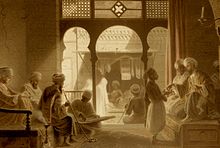
Essential to any cooking in the Arab world is the concept of hospitality and generosity. Meals are generally large family affairs, with much sharing and a great deal of warmth over the dinner table. Formal dinners and celebrations generally involve large quantities of lamb, and every occasion entails large quantities of Arabic coffee or Arabic tea.
Khaleej
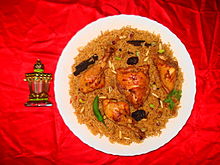
Coffee ceremony: In the Khaleej region, a visitor is greeted by a great table of dried fruits, fresh fruits, nuts and cakes with syrup. Dried fruits include figs, dates, apricots and plums. Fresh fruits include citruses, melons and pomegranate. Arabic Coffee is served the most, but Arabic tea is also a great refresher. Spices are often added in the coffee or other drinks.
Dinner guests: In the khaleej region, a visitor might expect a dinner consisting of a very large platter, shared commonly, with a vast amount of spiced rice, incorporating cooked spicy lamb or chicken, or both, as separate dishes, with various stewed vegetables, heavily spiced, sometimes with a tomato-based sauce. Different types of bread are served with different toppings specific to the region. Tea would certainly accompany the meal, as it is almost constantly consumed. Coffee would be included in the same manner.
Maghreb

Tea/coffee ceremony: In the Maghrebi region, a visitor might expect a table full of bread-like snacks, including Msemen, Baghrir and other stuffed breads. These are served with honey, rosewater or olive oil. There are also many different cookies and cakes included accompanied by plates with different kinds of nuts. Arabic coffee and Mint tea is often served with it in a traditional Maghrebian teapot.
Dinner guests: In the Maghrebi region, a visitor might expect a table with different kinds of stews, also called Marqas or Tajines. Dishes such as couscous or other semolina based dishes are much appreciated as well. These main dishes are accompanied by smaller mezze-like plates with salads, sauces and dips. Breads such as Msemen and Khobz are used to eat the stews.
Levant
Coffee/ Tea ceremony: In an average Arab Levantian household, a visitor might expect a table full of Mezzes, breads topped with spices including Za'atar and nuts. In the levant region, Arabic coffee is a much loved beverage, but Arabic tea is also much loved in Jordan and Palestine.
Dinner guests: In the Levantian region, a visitor might expect a table with different kinds of mezzes, nuts, dips and oils. Mezzes include Hummus, Baba ghanoush, Falafel, Kibbeh, Kafta, smoked vegetables and Tabouli salads. The nuts can differ from almonds to walnuts, with different spice coatings. The dips and oils include hummus and olive oil.
There are many regional differences in the Arab cuisine. For instance, mujadara in Syria and Lebanon is different from mujadara in Jordan and Palestine. Some dishes, such as mansaf (the national dish of Jordan), are native to certain countries and rarely, if ever, make an appearance in other countries. Unlike in most Western cuisines, cinnamon is used in meat dishes, as well as in sweets such as baklava. Dishes including Tajine and Couscous can differ from Morocco to Libya, with their unique preparations. Other dishes, such as the Arabo-Andalucian Bastilla or Albondigas have different traditional spicemixes and fillings in the Maghreb region.
Structure of meals
There are two basic structures for meals in the Arab World, one regular and one specific for the month of Ramadan.
Breakfast
Cafés often serve croissants for breakfast. Breakfast is often a quick meal, consisting of bread and dairy products, with tea and sometimes jam. The most used is labneh and cream (kishta, made of cow's milk).
Lunch
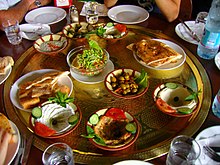
Lunch is considered the main meal of the day, and is traditionally eaten between 1:30pm and 2:30pm. It is the meal for which the family comes together, and when entertaining, it is the meal of choice to invite guests to. Rarely do meals have different courses; however, salads and mezze (an appetizer) are served as side dishes to the main meal. The platter usually consists of a portion of meat, poultry or fish, a portion of rice, lentils, bread and a portion of cooked vegetables, in addition to the fresh ones with the mezze and salad. The vegetables and meat are usually cooked together in a sauce (often tomato, although others are also popular) to make maraq, which is served on rice. Most households add bread, whether other grains were available or not. Drinks are not necessarily served with the food; however, there is a very wide variety of drinks such as shineena (or laban), karakaden, Naqe'e Al Zabib, irq soos, tamr Hindi, and fruit juice, as well as other traditional Arab drinks. During the 20th century, carbonated soda and fruit-based drinks, sold by supermarkets, have also become very popular.
Dinner
Dinner is traditionally the lightest meal, although in modern times, and due to changing lifestyles, dinner has become more important.
Desserts and Ramadan meals
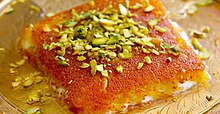
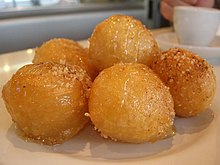
In addition to the two meals mentioned hereafter, sweets are consumed much more than usual during the month of Ramadan; sweets and fresh fruits are served between these two meals. Although most sweets are made all year round such as Kanafeh, baklava, and basbousa, some are made especially for Ramadan, such as qatayef.
Iftar
Iftar (also called Futuur), or fast-breaking, is the meal taken at dusk when the fast is over. The meal consists of three courses: first, they shall eat a date based on Islamic tradition. This is followed by a soup or anything they would like, the most popular being lentil soup, but a wide variety of soups such as chicken, oats, freeka (a soup made from whole wheat and chicken broth), potato, maash, and others are also offered. The third course is the main dish, usually eaten after an interval, when Maghreb prayer is conducted. The main dish is mostly similar to lunch, except that cold drinks are also served.
Sahur
Suhur is the meal eaten just before dawn, when fasting must begin. It is eaten to help the person make it through the day with enough energy until Maghreb time.
Regional Arab cuisines
Arabian Peninsula
Main article: Arab cuisine of the Persian GulfThe cuisine of Eastern Arabia today is the result of a combination of diverse cuisines, incorporating Levantine and Yemeni cuisines. Bukhari rice (روز البخاري) (Ruz al Bukhari) is a dish eaten in the Hejaz, Saudi Arabia. It is a rice with spicy tomato sauce, flavoured chicken and a fresh salad. It is a much eaten dish in the Hejaz district of Saudi-Arabia.
Yemen
Main article: Yemeni cuisine
The cuisine of Yemen is rather distinct from other Arab cuisines. Like most other Arab cuisines, chicken, goat, and lamb are eaten more often than beef. Fish is eaten mostly in coastal areas. However, unlike most Arab countries, cheese, butter, and other dairy products are less common, especially in the cities and other urban areas. As with other Arab cuisines, the most widespread beverages are tea and coffee; tea is usually flavored with cardamom, clove, or mint, and coffee with cardamom. Karakaden, Naqe'e Al Zabib, and diba'a are the most widespread cold beverages.
Although each region has their own variation, Saltah (سلتة) is considered the national dish of Yemen. The base is a brown meat is called maraq (مرق), a dollop of fenugreek froth, and sahawiq (سحاوق) or sahowqa (a mixture of chili peppers, tomatoes, garlic, and herbs ground into a salsa. Rice, potatoes, scrambled eggs, and vegetables are common additions to saltah. It is eaten with flat bread, which serves as a utensil to scoop up the food. Other dishes widely known in Yemen include: Aseedah, aseed, fahsa, thareed, Samak Mofa, mandi, fattah, shakshouka, shafut, Bint Al-Sahn, kabsa, and jachnun. Nasi kebuli Harees Hyderabadi haleem. Hadhrami restaurants can be found in Malaysia.
The Fertile Crescent: Mashriq
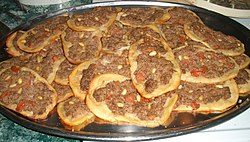
Levantine cuisine is the traditional cuisine of the Fertile Crescent. Although now divided into Syria, Lebanon, Jordan, Iraq, Egypt, and Palestine, the region has historically been more united, and shares most of the same culinary traditions. Although almost identical, there is some regional variation within the Levantine area.
Dishes include olive oil, za'atar, and garlic, and common dishes include a wide array of mezze or bread dips, stuffings, and side dishes such as hummus, falafel, ful, tabouleh, labaneh, and baba ghanoush.
It also includes copious amounts of garlic and olive oil, often seasoned with lemon juice—almost no meal goes by without including these ingredients. Most often foods are either grilled, baked, fried, or sautéed in olive oil; butter and cream are rarely used, other than in a few desserts. Vegetables are often eaten raw or pickled, as well as cooked. While the cuisine does not boast a multitude of sauces, it focuses on herbs, spices, and the freshness of ingredients.
Levant: Syria, Lebanon, Palestine, Jordan
Main article: Levantine cuisine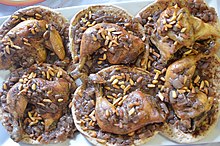
In Palestine and Jordan, the population has a cooking style of their own, involved in roasting various meats, baking flat breads, and cooking thick yogurt-like pastes from goat's milk.
Musakhan is a common main dish, famous in northern Jordan, the city of Jerusalem, and northern West Bank. The main component is taboon bread, which is topped with pieces of cooked sweet onions, sumac, saffron, and allspice. For large dinners, it can be topped by one or two roasted chickens on a single large taboon bread.
The primary cheese of the Palestinian mezze is Ackawi cheese, which is a semi-hard cheese with a mild, salty taste and sparsely filled with roasted sesame seeds. It is primarily used in Kenafah
Maqluba is another popular meal in Jordan and central Palestine. Mujaddara, another food of the West Bank, as well as in the Levant in general, consists of cooked green lentils, with bulghur sauteed in olive oil. Mansaf is a traditional meal, and the national dish of Jordan, having roots in the Bedouin population of the country. It is mostly cooked on special occasions such as Ramadan, Eid ul-Fitr, a birth, or a large dinner gathering.

Mansaf is a leg of lamb or large pieces of mutton, on top of a markook bread that has been topped with yellow rice. A type of thick dried yogurt made from goat's milk, called jameed, is poured on top of the lamb and rice to give it its distinct flavor and taste. The dish is garnished with cooked pine nuts and almonds.
Levantine cuisine is also famous for its wide range of cheeses, including Shanklish, Halloum, and Arisheh. Kishk is also a famous Syrian soup, alongside many soups made of lentils. Lebanese food also has a wide range of dips including Hummous, Baba Ghannouj, and Labneh, and also caters many raw meat dishes. Syrian food could be either extremely vegetarian or a meat lover's paradise. Lemon, oregano, za'atar, paprika, and various other Mediterranean spices and herbs are used in Syrian cuisine. To top it off,
Levantine cuisine also incorporates wines made in Lebanon, Syria, Jordan and Palestine and the Levantine equivalent of the Greek Ouzo, known as Arak.
Iraq
Main article: Iraqi cuisine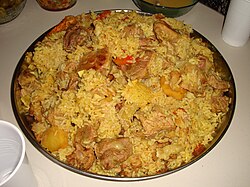
Iraq is where the first cookbook was ever recorded in history, historically in Baghdad and Mesopotamia. Iraq is one of the oil-rich Arab countries surrounding the Persian gulf and is also part of the Levant and Mashriq sharing similarities in cooking and cuisines between both the surrounding regions of the Arab world. Iraqi cuisine mainly consists of meat, rather than appetizers. In Iraqi cuisine, the most common meats are chicken and lamb. The national dish of Iraq is the Masgouf fish, usually enjoyed with grilled tomatoes and onions. Iraqi cuisine uses more spices than most Arab cuisines. Iraq's main food crops include wheat, barley, rice, vegetables, and dates. Vegetables include eggplant, okra, potatoes, and tomatoes. Pulses such as chickpeas and lentils are also quite common. Common meats in Iraqi cooking are lamb and beef; fish and poultry are also used.
Soups and stews are often prepared and served with rice and vegetables. Biryani, although influenced by Indian cuisine, is milder with a different mixture of spices, and a wider variety of vegetables, including potatoes, peas, carrots, and onions. Dolma is also one of the most popular dishes.
The Iraqi cuisine is famous for its extremely tender kebab, as well as its tikka. A wide variety of spices, pickles, and amba are also extensively used.
Egypt
Main article: Egyptian cuisine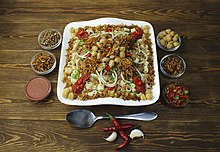

Egypt has a very rich cuisine with many unique customs. These customs also vary within Egypt itself, for example, in the coastal areas, like the coast of the Mediterranean Sea and Canal, the diet relies heavily on fish. In the more rural areas, reliance on farm products is much heavier. Duck, geese, chicken, and river fish are the main animal protein sources. While Egyptians eat a lot of meat, Egyptian cuisine is rich in vegetarian dishes; three national dishes of Egypt; ful medames, ta'miya (also known in other countries as falafel), and kushari, are generally vegetarian. Fruits are also greatly appreciated in Egypt: mangoes, grapes, bananas, apples, sycamore, guavas, and peaches are very popular, especially because they are all domestically produced and are available at relatively low prices. The most famous dessert from Egypt is called Om Ali, which is similar to a bread and butter pudding made traditionally with puff pastry, milk, and nuts. It is served all across the Middle East and is also made on special occasions such as Eid. Bread is a staple in Egypt, the most common breads are eish baladi (Template:Lang-ar) and eish merahrah (Template:Lang-ar).
Maghreb
Main article: Maghreb cuisine See also: Algerian cuisine, Moroccan cuisine, Tunisian cuisine, Libyan cuisine, Mauritanian cuisine, and Western Saharan cuisineMaghreb cuisine is the cooking of the Maghreb region, the northwesternmost part of Arab world along the Mediterranean Sea, consisting of the countries of Algeria, Libya, Morocco, and Tunisia.
Libya
Main article: Libyan cuisine
Libyan cuisine derives much from the traditions of Maghreb and Mediterranean cuisines. One of the most popular Libyan dishes is Bazin, an unleavened bread prepared with barley, water and salt. Bazin is prepared by boiling barley flour in water and then beating it to create a dough using a magraf, which is a unique stick designed for this purpose. Pork consumption is forbidden, in accordance with Sharia, the religious laws of Islam. Tripoli is Libya's capital, and the cuisine is particularly influenced by Italian cuisine. Pasta is common, and many seafood dishes are available. Southern Libyan cuisine is more traditionally Arab and Berber. Common fruits and vegetables include figs, dates, oranges, apricots and olives.
Libyan kitchen also includes hot spices, like Tunisia. Bazin – Libyan bread, Bsisa, Couscous, Harissa, Hassaa, Lebrak – Filled grapeleaves with rice and minced meat, Libyan Boureek, Libyan summer salad, Marqa or Tajine, Madrouba, Mbatten, Mbekbka – a unique Libyan soup with pasta or spaghetti. Instead of the European way of boiling pasta or spaghetti in water and then throwing the water away (with all the goodness it contains), the Libyans boil pasta with the sauce, which adds a real pasta flavour to the sauce. You can make it with any type of pasta, and the simplest dish involves frying onions in oil, throwing in the tomato puree, chili powder, turmeric, then adding water and salt and leave to boil, before adding the pasta. But the proper way to do it is to add some lamb chops, chickpeas and garlic to the sauce. Serve hot with a sprinkle of extra virgin olive oil, lemon, fresh chili and crusty bread (optional). One can also add other vegetables such as pumpkin, potato and green pepper, Maglouba, Shakshouka, Sherba, Usban, Zumita and Asida. Desserts and beverages includes, Makroudh, Libyan tea, Ghoriba, Maakroun, Mafruka and Mhalbiya.
Tunisia
Algeria
Morocco
Main dishes
- Bastilla (Arabic: بسطلة): The pancake is a traditional Moroccan tart filled with pigeons or chicken.
- Harira (Arabic:حريرة): a traditional Moroccan tomato soup consumed during the Holy month of Ramadan. It is a thick soup with beans and vegetables in it.
- Taktouka (Arabic:تكتكة): a traditional Moroccan salad made with tomatoes, onions, coriander and smoked green paprika.
- Zaalouk:
Breads and pancakes
- Khobz (Arabic:خبز): a type of bread consumed with broths such as Tajine.
- Msemen (Arabic:مسمن): The word Msemen is derived from Smen, clarified butter widely used in Arab cuisine. Msemen is a type of bread that is consumed on its own with honey or olive oil.
- Baghrir (Arabic:بغرير): a type of pancake with many holes in it, consumed in Morocco and other Maghreb countries.
- Harcha (Arabic:حرشة ): a type of bread made of Semolina, consumed in during breakfast or during high tea, together with honey or butter.
Moroccan spice mixes
- Chermoula (Arabic:شرمولة): a marinade used to flavor fish or seafood and other meats and vegetables. Chermoula is often made of a mixture of herbs, oil, lemon juice, pickled lemons, garlic, cumin, and salt.
- Ras el Hanout (Arabic:راس الحانوت): Ras el Hanout means "head of the store", and is an Arab spice mix made with 20 or more spices and herbs.
- Harissa
Sweets and pastries
- Chebakia (Arabic:شبكية): Chebakia is derived from the Arabic word "Chabaka" meaning "baskets" is a traditional pastry eaten during the Holy month of Ramadan.
- Kaab el Ghazal (Arabic:كعب الغزل ): Kab el Ghazal literally translates from Moroccan Arabic as "gazelle ankles"; these crescent-shaped cookies are famously known as Gazelle Horns, or Cornes de Gazelle in French. They are frequently served at special occasions, including Eid and visitations. Almond paste scented with orange flower water and cinnamon is enclosed in a delicate pastry, molded into a crescent, and then baked until golden. A dip in orange flower water followed by a dusting of powdered sugar is optional – in that case, the pastries are referred to as Kaab el Ghazal M'fenned.
- Briouat (Arabic بريوات ): Briout means "little envelopes" in Arabic. It is a pastry made by wrapping a filling in thin pastry dough and then frying. The fillings might be savory or sweet. In the popular almond briouat version, the pastries are filled with fresh almond paste flavored with orange flower water and cinnamon. Once fried, the pastries are then given a short soaking in hot honey for flavor and sweetness. Almond briouats are commonly served at both special occasions and casual tea times.
Sudan
Main article: Sudanese cuisine
In comparison to its Maghreb and Levantine neighbors, the cuisine of Sudan tends to be generous with spices. The Sudanese cuisine has a rich variety in ingredients and creativity. Simple everyday vegetables are used to create stews and omelettes that are healthy yet nutritious, and full of energy and flair. These stews are called mullah. One could have a zucchini mullah, spinach "Riglah" mullah, etc. Sudanese food inspired the origins of Egyptian cuisine and Ethiopian cuisine, both of which are very popular in the Western world. Popular dishes include Ful medames, Shahan ful, Hummus, Bamya (a stew made from ground, sun dried okra), and Gurasa (pancake), as well as different types of salads and sweets.
Dishes
| Name | Image | Description |
|---|---|---|
| Basbousa بسبوسة | 
|
|
| Dolma ضولمة | 
|
|
| Ful Medames فول مدمس | 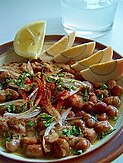
|
An Egyptian dish of cooked and mashed fava beans served with vegetable oil, cumin, and optionally with chopped parsley, onion, garlic, lemon juice, and chili pepper. |
| Kleeja كليجا | 
|
|
| Maqluba مقلوبه | 
|
|
| Mutabbaq مطبق | 
|
A stuffed pancake or pan-fried bread commonly found in Saudi Arabia (especially the Tihamah and the Hejaz regions), Yemen, India, Indonesia, Malaysia, Singapore, Brunei and Thailand. |
| Pickled lemon ليمون مخلل | 
|
|
| Shish kebab كباب | 
|
|
| Tharida | A soup prepared chicken water and egg. |
Gallery
-
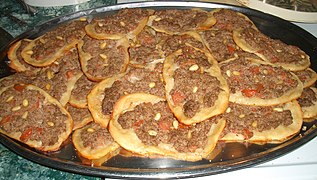 Lahm Ba'ajeen لحم بعجين
Lahm Ba'ajeen لحم بعجين
-
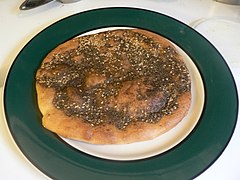 Manakish مناقيش
Manakish مناقيش
-
 Kabsa كبسة
Kabsa كبسة
-
Kebbeh كبة-كبيبة
-
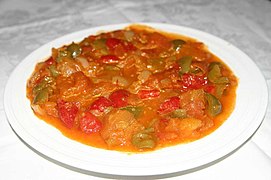 Matboha مطبوخة
Matboha مطبوخة
-
 Baba Ghanoush بابا غانوج
Baba Ghanoush بابا غانوج
-
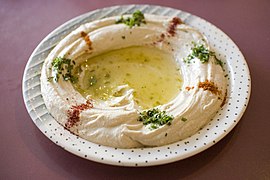 Hummus حمصية
Hummus حمصية
-
 Waraq Enab ورق عنب - ملفوف
Waraq Enab ورق عنب - ملفوف
-
 Labneh لبنة
Labneh لبنة
-
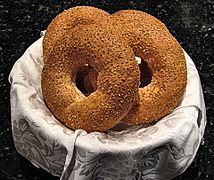 Ka'ak كعك - كحك
Ka'ak كعك - كحك
-
 Coffee قهوة
Coffee قهوة
-
 Hibiscus tea كركديه - عنآب
Hibiscus tea كركديه - عنآب
-
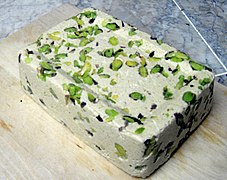 Halva حلاوة
Halva حلاوة
- Qatayef القطائف Qatayef القطائف
-
 Shish taouk شيش طاوك
Shish taouk شيش طاوك
-
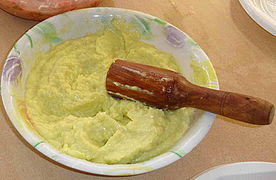 Toum تومية
Toum تومية
-
 Falafel فلافل - طعمية
Falafel فلافل - طعمية
-
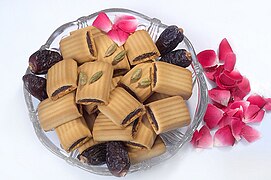 Kleicha الكليجة - كعب الغزال
Kleicha الكليجة - كعب الغزال
-
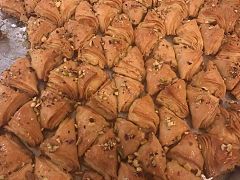 Warbat وربات
Warbat وربات
-
 Ghoriba غريبة
Ghoriba غريبة
-
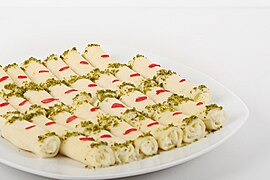 Halawet el Jibn حلاوة الجبن
Halawet el Jibn حلاوة الجبن
-
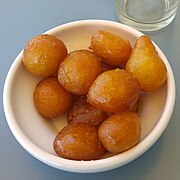 Awameh عوامة
Awameh عوامة
-
 Sfouf
Sfouf
-
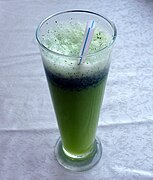 Limonana ليمون نعناع
Limonana ليمون نعناع
-
 Harees هريس
Harees هريس
See also
- Algerian cuisine
- Egyptian cuisine
- Iraqi cuisine
- Jordanian cuisine
- Levantine cuisine
- Lebanese cuisine
- Libyan cuisine
- List of Arab salads
- Moroccan cuisine
- Omani cuisine
- Palestinian cuisine
- Syrian cuisine
- Tunisian cuisine
- Yemeni cuisine
References
- Flandrin, under the direction of Jean-Louis; al.], Massimo Montanari ; English edition by Albert Sonnenfeld ; translated by Clarissa Botsford ... [et (1999). Food : a culinary history from Antiquity to the present (English ed.). New York: Penguin Books. ISBN 0-231-11154-1.
{{cite book}}: CS1 maint: multiple names: authors list (link) - Nabeel Y. Abraham. "Arab Americans", Encarta Encyclopedia 2007. Archived 2009-10-31.
- "Desserts & Sweets in Arabia".
- "Daily Traditional Gulf Cuisine food recipes". Shahiya.com. Retrieved 2016-01-07.
- "Hadhramaut continues to highlight Arabic presence in Malaysia - Culture & Art - 13/12/2013". KUNA.net. 2013-12-13. Retrieved 2016-01-07.
- "KUNA : Hadhramaut continues to highlight Arabic presence in Malaysia - Culture & Art - 13/12/2013". 158.50.10.7. 2013-12-13. Retrieved 2016-01-07.
- Grace Chen (2012-07-07). "Middle Eastern restaurants thriving in Malaysia". The Star. Malaysia. Retrieved 2016-01-07.
- "Umm Ali Recipe - Egyptian Bread Pudding".
- Rozario, P. (2004). Libya. Countries of the world. Gareth Stevens Pub. p. 40. ISBN 978-0-8368-3111-5.
- Davidson, A.; Jaine, T.; Davidson, J.; Saberi, H. (2006). The Oxford Companion to Food. Oxford Companions. OUP Oxford. p. 1356. ISBN 978-0-19-101825-1.
- ^ "Libya". Foodspring.com. Accessed June 2011.
- "The Art of Moroccan Cuisine | Fes Cooking and Cultural Tours". Fescooking.com. Retrieved 2013-11-06.
- Fatema Hal, "Authentic Recipes from Morocco". 13 July 2016
- "Gazelle Horns - Traditional Moroccan Cookies with Almond Paste". Retrieved 20 October 2017.
- "134 - Gazelle Horns Covered with Sesame Seeds / "Kab-El-Ghazal" Recipe - Cooking with Alia". 24 February 2015. Retrieved 20 October 2017.
- "Learn to Make Almond Briouats with These Step-by-Step Photos". Retrieved 20 October 2017.
External links
- Popular Arabic Recipes
 Media related to Arabic cuisine at Wikimedia Commons
Media related to Arabic cuisine at Wikimedia Commons
| African cuisine | |
|---|---|
| Sovereign states |
|
| States with limited recognition | |
| Dependencies and other territories |
|
| Middle Eastern cuisine | |
|---|---|
| Mediterranean cuisine | |||||||||||||||||||||||||||||
|---|---|---|---|---|---|---|---|---|---|---|---|---|---|---|---|---|---|---|---|---|---|---|---|---|---|---|---|---|---|
| Regions |
| ||||||||||||||||||||||||||||
| Staples | |||||||||||||||||||||||||||||
| Shared | |||||||||||||||||||||||||||||
| Exemplars | |||||||||||||||||||||||||||||
| Lists of prepared foods | |||||||||||||||||||||
|---|---|---|---|---|---|---|---|---|---|---|---|---|---|---|---|---|---|---|---|---|---|
| Dishes by origin |
| ||||||||||||||||||||
| By type and origin |
| ||||||||||||||||||||
| By type |
| ||||||||||||||||||||
